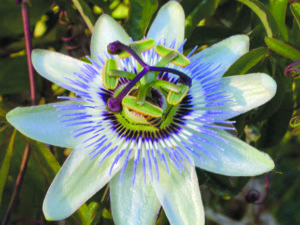
 If you’ve ever had the pleasure of walking Glendoveer Golf Course in Portland, you can’t help but pass by the most fascinating flower created—the passionflower. It is incredible in design, beauty and elegance. Laced with rich colors of purple and white spindles, this flower boasts many other elements, which adds to the mystic appearance of this flower.
If you’ve ever had the pleasure of walking Glendoveer Golf Course in Portland, you can’t help but pass by the most fascinating flower created—the passionflower. It is incredible in design, beauty and elegance. Laced with rich colors of purple and white spindles, this flower boasts many other elements, which adds to the mystic appearance of this flower.
History tells us that in 1620, a Jesuit priest came across the plant we now know as passionflower. Enthralled with its beauty, that night he had a vision likening its floral parts to the elements of the Crucifixion or Passion of Christ. The five petals and five sepals became the ten apostles (omitting Peter and Judas). The three pistils became the nails of the cross. The purple corona was the crown of thorns, and the stemmed ovary was the Lords’ goblet.
There are over 460 known species of Passiflora. These “maypops,” as they’re also known, have woody vines with flowers in a combination of colors. The plant produces small, berry–like fruit called granadilla or “water lemon.” The aerial parts of the plant can be gathered during fruiting season and then dried for future processing.
In addition to its symbolic appearance, the passionflower has medicinal attributes. It can be used in the treatment of insomnia nervousness, and it is also used as a sedative in nervous disorders (including some gastrointestinal complaints), difficulties in sleeping, anxiety, or restlessness. Among herbalists, passionflower is known to reduce spasms and depress the central nervous system. Better yet, studies have shown that its mode of action is different than that of most sedative drugs, thus making it a non–addictive herb to promote relaxation.
While the safety and effectiveness of this plant has not been thoroughly proven in scientific studies, one study including 36 men and women with generalized anxiety disorder found that passionflower was as effective as a leading anti–anxiety medication when taken for one month. A second study including 91 people with anxiety symptoms revealed that an herbal European product containing passionflower and otherherbal sedatives significantly reduced symptoms compared to a placebo.
Interestingly, passionflower may also relieve anxiety in people who are recovering from heroin addiction. In a study including 65 heroin addicts, those who received passionflower in addition to a standard detoxification medication experience significantly fewer feelings of anxiety than those who received the medication alone.
There are no reported side–effects for passionflower with most herbalist’s suggested dosages. However, it is not recommended for use in pregnant women or children under the age of two. If already taking a sedative or tranquilizer, consult a health-care professional before using passionflower. For more information on the passionflower visit www.passionflower.org.
No Comments
Leave a comment Cancel